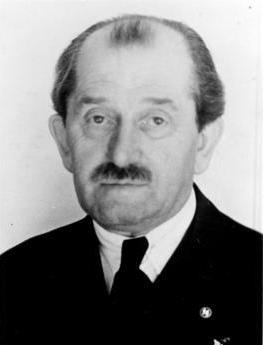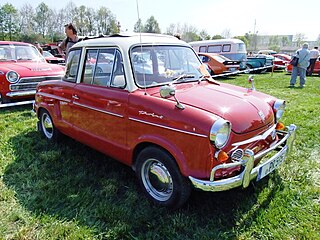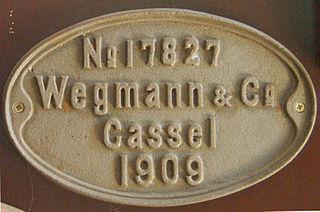
Wendler was a German wheelwright and car body manufacturer in Reutlingen.

Wendler was a German wheelwright and car body manufacturer in Reutlingen.
The company was opened by Erhard Wendler in 1840 as a carriage factory. Initially, he manufactured carriages, and from the early 1920s, car bodies as well. The designer Helmut Schwandner initiated the reorientation. In the 1920s, around 60 bodies were built, and in the 1930s there were 250 to 270. The workforce consisted of around 100 employees. One of the customers in 1937 was the architect Wilhelm Ritter von Graf. [1] [2]
After the Second World War, Wendler resumed the production of car bodies, which were now built in the ponton shape. Series production continued until the end of the 1950s, then the focus shifted mainly to repairs.
One of Wendler's most important clients was Porsche, who, among other things, had Wendler build 90 light-alloy bodies (according to other sources, more than 100) for the Porsche 550. For the 1961 24 Hours of Le Mans, Wendler designed a Porsche coupé, but it was never built. Instead, he developed his own car based on a Porsche, the W-RS 001. [3]
Later, the company was involved in vintage car restoration and special construction of armored limousines.
In 2000, Wendler became insolvent. [4] The company continued to operate under the name Pgam AG until its final closure. [5]

Ferdinand Porsche was an Austrian-Bohemian-German automotive engineer and founder of the Porsche AG. He is best known for creating the first gasoline–electric hybrid vehicle (Lohner–Porsche), the Volkswagen Beetle, the Auto Union racing cars, the Mercedes-Benz SS/SSK, and several other important developments and Porsche automobiles.

Auto Union AG was an amalgamation of four German automobile manufacturers, founded in 1932 and established in 1936 in Chemnitz, Saxony. It is the immediate predecessor of Audi as it is known today.

The Mercedes-Benz E-Class is a range of executive cars manufactured by German automaker Mercedes-Benz in various engine and body configurations. Produced since September 1953, the E-Class falls as a midrange in the Mercedes line-up, and has been marketed worldwide across five generations.

NSU Motorenwerke AG, or NSU, was a German manufacturer of automobiles, motorcycles and pedal cycles, founded in 1873. Acquired by Volkswagen Group in 1969, VW merged NSU with Auto Union, creating Audi NSU Auto Union AG, ultimately Audi. The NSU name came from the city it was based in, Neckarsulm, contracted to three letters.
Steyr-Daimler-Puch was a large manufacturing conglomerate based in Steyr, Austria, which was broken up in stages between 1987 and 2001. The component parts and operations continued to exist under separate ownership and new names.

The Mercedes-Benz W123 is a range of executive cars produced by German manufacturer Mercedes-Benz from November 1975 to January 1986. The W123 models surpassed their predecessor, the Mercedes-Benz W114, as the most successful Mercedes, selling 2.7 million units before production ended in the autumn of 1985 for the saloon/sedan versions and January 1986 for coupés and estates/station wagons.

The Mercedes-Benz W124 is a range of executive cars made by Daimler-Benz from 1984 to 1997. The range included numerous body configurations, and though collectively referred to as the W-124, official internal chassis designations varied by body style: saloon (W 124); estate (S 124); coupé (C 124); cabriolet (A 124); limousine (V 124); rolling chassis (F 124); and long-wheelbase rolling chassis (VF 124).

Horch was a German car manufacturer, which traced its roots to several companies founded in the very late 19th and early 20th century by August Horch.

The NSU Prinz (Prince) is an automobile which was produced in West Germany by the NSU Motorenwerke AG from 1958 to 1973.

The Tatra 87 (T87) is a car built by Czechoslovak manufacturer Tatra from 1936 to 1950. It was powered by a rear-mounted 2.9-litre air-cooled 90-degree overhead cam V8 engine that produced 85 horsepower and could drive the car at nearly 100 mph (160 km/h). It is ranked among the fastest production cars of its time. Competing cars in this class, however, used engines with almost twice the displacement, and with fuel consumption of 20 liters per 100 km. Thanks to its aerodynamic shape, the Tatra 87 had a consumption of just 12.5 litres per 100 km. After the war between 1950 and 1953, T87s were fitted with more-modern 2.5-litre V8 T603 engines.

The Steiger company was founded in 1914 as Maschinenfabrik Walther Steiger & Co. by the Swiss engineer Walther Steiger (1881–1943) in Burgrieden near Ulm, Germany. In 1921 it became a limited company. During its short life the firm produced circa 1,200 vehicles.

Bombardier Transportation Austria GmbH is an Austrian subsidiary company of Bombardier Transportation located in Vienna, Austria.

The Auto Union Grand Prix racing cars types A to D were developed and built by a specialist racing department of Auto Union's Horch works in Zwickau, Germany, between 1933 and 1939, after the company bought a design by Dr. Ferdinand Porsche in 1933. The Auto Union type B streamlined body was designed by Paul Jaray.

Paul Jaray was a Vienna-born engineer, designer, and a pioneer of automotive streamlining.

The Adler Trumpf Junior is a small family car introduced by the Frankfurt based auto-maker Adler, early in 1934. Trumpf Junior was conceived as a similar but smaller version of the Adler Trumpf, which had already been available for two years. It intended to broaden the range and claim a share of a growing market which DKW were creating with their F1 model, and its successors, for small inexpensive front wheel drive cars.

The Egger-Lohner C.2 Phaeton, erroneously called Porsche P1, is an electric vehicle built by Egger-Lohner. It is the first vehicle that Ferdinand Porsche somewhat contributed to. The vehicle resembles a horse-drawn carriage with an electrical motor attached to it. Approximately 4 were built.

The form coach factory of Wegmann & Co. was founded in 1882 in Kassel by Kommerzienrat, Peter Wegmann, and Richard Harkort as the Casseler Waggonfabriken von Wegmann, Harkort & Co. In 1886 it changed its name to Wegmann & Co.

Karosserie Friedrich Rometsch, a German metallurgical-coachbuilding company based in Berlin-Halensee, Nestorstrasse 41, manufactured, modified, and repaired coaches, trailers, bodies and chassis.

Motorenfabrik Paul Baer GmbH was a German engine and automobile manufacturer.
Carrosserie + Spritzwerk Beutler AG, previously Gebr. Beutler & Cie. and Carrosserie Beutler AG was a Swiss coachbuilder that manufactured handcrafted bodies on passenger car chassis.